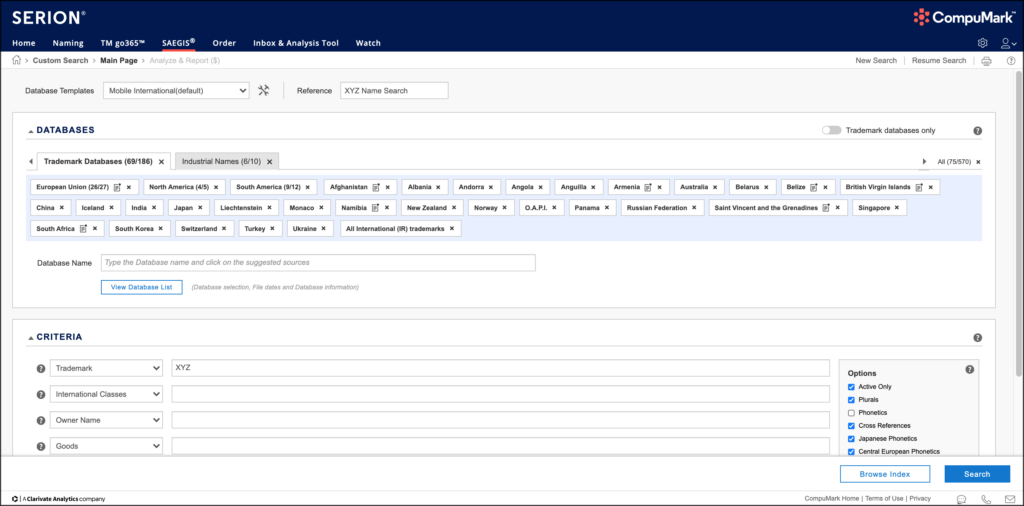It might be the biggest letdown in naming: You’ve got your heart set on a particular name candidate only to discover, late in the game, that somebody else owns it—or something close enough to it to be considered “confusingly similar.”
Trademark checks are essential. If you’re serious about naming, then at some point you’re also serious about making sure you will be able to trademark the name you want. In an era when most of the obvious, straightforward choices for names in a given category have been taken, it’s naive to think otherwise.
Teeing up trademark counsel. In most cases, the names we generate ultimately go to a trademark attorney for final vetting and then legal registration. Before that, our job is to provide a smooth handoff—to deliver finalists to the client that either (a) aren’t likely to run into trademark conflicts, or (b) have known risks that the client, for their own reasons, deems acceptable.
Most often, this search falls to me to conduct. Here’s how I go about it:

What we check. First, our process includes checking both the URL availability and any trademark conflicts for the top 12 or so candidates we feature in each presentation round. (The full round usually consists of well over a hundred candidates, from which we select a dozen or so to lead a more focused conversation.) For trademark searches, we use a service CompuMark™ by Clarivate Analytics https://clarivate.com/compumark/
This service aggregates search findings from a variety of US and global databases. The results are clear and easy to understand.
Red, yellow, green. With the results in hand, we label our findings either “green” (few if any results, and no apparent conflicts), “yellow” (more results and some possible hits, but nothing that appears to be a direct conflict outright), or “red” (potentially problematic). Keep in mind that “red” candidates aren’t always non-starters. We might still present them and leave the final decision to the client. We’ve learned different companies are willing to accept different degrees of risk, and decision makers who live a name despite the risk might decide to fight for it.
My search approach. I begin my searches wide and then narrow in. As a rule, I search Active trademarks only. I typically don’t include Inactive trademarks because I’ve found they don’t add much value, for our purposes, and they tend to muddy the results.
From a geographic standpoint, my default search includes databases for North America, the European Union, China, Japan, Australia, New Zealand, South America and a number of other, smaller countries. This reflects the actual or intended scope of international business our clients intend to pursue. We can customize the geographic search if a client so desires. Recently, we did so for a client intending to use a name across Latin America.
Things get interesting when a search turns up a hit in China, Germany or a Scandinavian country and the description of the company, its line of business and trademark are not translated into English. We’ve used Google Translate in cases when the name seems to be identical and the International Classes (the numbers assigned to specific categories of goods and service) are identical to see what we are working with.
When to dive deeper? In the interest of using time and money wisely, we don’t necessarily investigate every single hit our search efforts yield. If, after using all of the above criteria, we discover fewer than, say, six hits on a name candidate, then we review them individually for a clearer picture of what’s going on. If we encounter say, seven to 12 hits, then we enter a category descriptor such as “Real Estate” or “Fashion” or “Software” to get a better read. If our search produces 12 or more hits, then we tend to hold off going deeper until we understand the degree to which the client might be interested in such a name. (In the meantime, we’d tend to label the name candidate “yellow”.) If we encounter lots and lots of hits, we can be reasonably certain that a given name candidate is likely to come with significant trademark risk. We’ll probably label it “red”.
Today’s green is tomorrow’s red. Assuming you follow steps like these for the few dozen candidates you’re likely to check over the course of a naming assignment, then you’ll be delivering insights of real value to the client. Just one thing: Don’t sit on a set of search findings and expect them to remain current for long. We remember a case in which a client waited six months to register a name we had labeled “green”. They called us in dismay when the name they favored was no longer available. Sure enough, a company in a similar line of business had registered the name during the intervening period. We took care of the client, of course, and found a new name for them, but they were never entirely happy after the loss they felt they had endured. The naming space is dynamic. Our general advice? Choose it or lose it.
